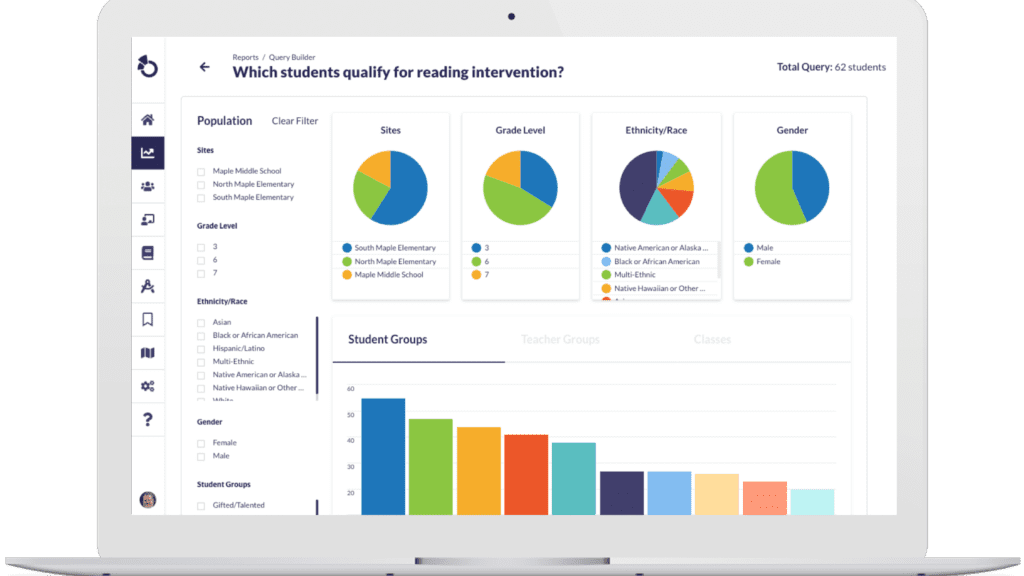For, to, and with: 3 Key Prepositions for Thinking Through AI Decisions
By: Otus Team
As a digital learning consultant with the Ohio Valley Educational Cooperative, Adam Watson advises OVEC’s 14 districts based on their objectives and goals. He gathers comprehensive information about what is needed and then helps districts outline the best digital solutions for their 150,000 students.
We sat down with Adam Watson to talk about one of the biggest technologies looming over schools right now: artificial intelligence.
Conversations about AI in education often start with what the technology can do for educators, but K-12 edtech expert Adam Watson prefers to keep the focus on the humans who will be using it.
Watson is enthusiastic about AI, which he describes as “a quantum leap beyond the usual education technology change.” But although he believes AI can redefine edtech, he also believes its implementation must align with classroom needs and follow best practices for both purpose-centered and human-centered use.
While this sounds like a tall order, Watson points out that it’s not any different from past technologies—going all the way back to the chalkboard. Yes, the introduction of the chalkboard at Yale University in 1830 caused a fracas. Students balked at following the rules for its use. Teachers bristled at the extra work it caused.
When Watson started as a technology integration coach in 2014, his district was implementing a new 1-to-1 device policy. Questions quickly arose about intentionality: What should the students do with these Chromebooks they were suddenly carrying around everywhere?
Watson has never stopped asking questions about intentionality and education technology—not only of school leaders and educators, but also of edtech providers.
Which brings us back to AI. Whether it is used as a standalone generative tool or an integration like AI Insights, the embedded assistant in the Otus platform, AI can make educators’ lives easier and their teaching more effective for student learning.
Much depends on whether districts are looking for a tool that will enhance the things they already do or one that will transform their approach. Leveraging AI in innovative ways can change the experience of education in their schools and provide an opportunity for students who are not thriving under the status quo.
An intentional approach to evaluating AI tools
When Watson advises education leaders on edtech tools, he suggests they consider these three prepositions to help ground their decision in purpose:
- A tool for …
- A tool to …
- A tool with …
Here’s a walkthrough of how each of these prepositions might apply to AI Insights.
A tool for … making sense of data
 AI embedded within a comprehensive platform like Otus can be an ally because teachers are assaulted by data. Analyzing and making sense of it all can be overwhelming and time-consuming. For example, educators spend a great deal of energy deciding which students need what level of intervention. A tool that can help figure this out efficiently has tremendous value.
AI embedded within a comprehensive platform like Otus can be an ally because teachers are assaulted by data. Analyzing and making sense of it all can be overwhelming and time-consuming. For example, educators spend a great deal of energy deciding which students need what level of intervention. A tool that can help figure this out efficiently has tremendous value.
Another example Watson offers is using AI as a tool for broadening the range of options through which students can demonstrate mastery. In traditional systems, Watson explains, mastery is determined by autopsy after an exam. AI can help educators take into account skills and knowledge that were not at the forefront previously.
Often, the “for” preposition can lead to other conversations. If AI is to be a tool for saving time, for instance, Watson says leaders need to consider what educators will be expected to do with the time they’re saving. Or, if AI is to be a tool for building relationships, how will that contribute to a human-centered approach to education within the district?
A tool to … bring data alive
By now, most of us have utilized an AI prompt to retrieve data. This functionality is becoming ubiquitous, and it’s especially useful for teachers to be able to use natural-language inquiries to find the data points they need without having to learn new jargon or memorize unwieldy prompts. Because an embedded assistant like AI Insights can index everything a student has done, queries yield comprehensive, actionable data.
Watson urges district leaders considering AI assistants to look for tools that are designed to transform the educational experience, rather than being "retrofitted," and that align with the roadmap the district already has in place. As an example, Watson mentioned learning management systems of the past, which were made for gradebooks of points and percentages, trying and failing to incorporate standards-based grading.
Otherwise, if the platform doesn’t offer the functionality their educators need, providers might ask them to jump through hoops to add features and upgrades, which can be costly. Or they might layer functionality onto a platform that was designed to do something else, making it creaky.
A tool with … access to multiple data sources
Watson says having too many sources of information is like getting caught up in a spider web. It’s easy to get entangled, and extricating yourself takes time and energy. The most useful AI tools are designed to unstick the web while retaining the interconnected information.
When teachers have an easier time with data retrieval, they can focus more on instruction and classroom management, whether it’s a single elementary classroom of 25 kids or multiple high school classes totaling hundreds of students throughout the day.
Being true to who you are as a district
Watson cautions districts not to ignore legitimate concerns with AI tools. These include privacy, ethical use, hallucinations, student cheating, and environmental impact, and they’re leading to a decrease in support for AI among the general public.
Because AI in edtech is moving so fast, transparency and communication are hugely important. Districts that have thought through their philosophy around AI use will be ahead of the game when choosing platforms. Ideally, district leaders should seek input from all stakeholders, including teachers, staff, parents, and students, as part of their decision-making process.
Over the past few years, education communities have invested deeply in self-discovery around their values, their identity, and the characteristics they want to impart in their graduates. Watson reminds school leaders that adding a new technology—whether it’s a chalkboard or an AI assistant embedded in a data platform—shouldn’t change who they are as a community.
Adam Wilson is a digital learning consultant with the Ohio Valley Educational Cooperative. His first book, Tabletop Role-Playing Games in the Classroom: Infusing Gameplay into K-12 Instruction, will be published in late 2025.

The Otus Team
The Otus team is made up of former school leaders and educators with a combined total of over 200 years of experience. Together, we’re committed to giving educators the insights they need to support every student’s success.
Related Resources
Request a demo!
See exactly how Otus can help your school accelerate student growth and improve student outcomes – all while saving educators time.





